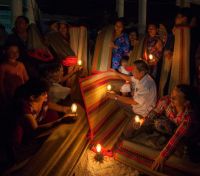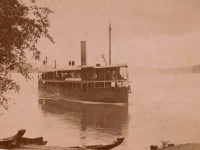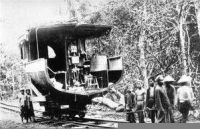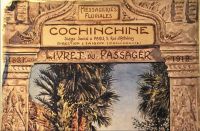
Shadows drift quietly through the market after nightfall.
They are burdened with large loads that hide them from the glare of street lights, and with the weariness of the day past.
Both loads are revealed as they glide past the lampposts, the earthly loads in colors much brighter than the immaterial ones. Bright yellow here, rich red there, have tinted forever their hands and their souls.
Where they lay their goods down on the pier, they stage them carefully. In the flicker of oil lamps, one can discern the main product of the village is rush mats. In another hour the market will be alive with buyers, on the road or even by boats, who wait til night to coast. Such is the quality of the mats of Định Yên.
→ Read more...

I knew this was going to be the big night.
Tonight, it was not going to be a walk through a crowd in the dark, with mom holding my hand all the time: big sister Thi promised she would take me with her tonight. She said we would go on the river with Papy Thống on his tourist boat.
We'll go cast lanterns on the river.
→ Read more...

Power and neglect
The adventure and passion for the river must have dwindled with the advent of the later contracts: in 1914, no question of a 20-years monopoly anymore, and the terms were tightened so much as to turn the Messageries essentially into an administration.1) Between the ebb and flow of the Mekong, the lack of diligence of the officers in charge and insufficient infrastructures, The Messageries, went on neglecting their duties until the outrage flared in the late 20s.
→ Read more...

a time for adventure
The Messageries fluviales took a central part in the logistics of the 1893 expeditions upstream to Laos, with launches like the Hàm Luông, Lagrandière, or Massie, which allowed access up to Luang Prabang and even to the Golden Triangle and the Southernmost confines of China. But at that time, like today, the Khôn falls, at the 4000 islands, prevented steamers from crossing the Mekong upwards from Cambodia to Laos. In order to transport the first launches to the first bief upstream, the Messageries installed on the large Khôn island first a metric railway with three hand-powered carts, then a real railway when commercial traffic took up.
→ Read more...

Uncertain origins
The history of the Messageries takes us back to the 1870s, at a time when the French admiralty was supporting about three thousand troops in Cochinchina and when the Saigon port, then a little over fifty thousand inhabitants, was hosting the Colonial Council, which, before the time of Governor General Paul Doumer, was levying taxes from the indigenous population and employing them in a discretionary fashion. That is also to say, if you wanted to set up a trade in those times, you needed a real spirit of adventure and a strong will, or much political clout in this small pond.
→ Read more...








